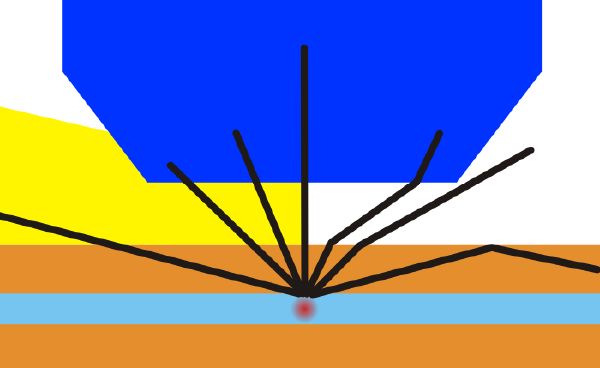(Created page with "== Microscopy with Oil Immersion and inspection of previous samples== "In light microscopy, oil immersion is a technique used to increase the resolving power of a microscope....") |
|||
| Line 2: | Line 2: | ||
"In light microscopy, oil immersion is a technique used to increase the resolving power of a microscope. This is achieved by immersing both the objective lens and the specimen in a transparent oil of high refractive index, thereby increasing the numerical aperture of the objective lens. Immersion oils are transparent oils that have specific optical and viscosity characteristics necessary for use in microscopy."(https://en.wikipedia.org/wiki/Oil_immersion) | "In light microscopy, oil immersion is a technique used to increase the resolving power of a microscope. This is achieved by immersing both the objective lens and the specimen in a transparent oil of high refractive index, thereby increasing the numerical aperture of the objective lens. Immersion oils are transparent oils that have specific optical and viscosity characteristics necessary for use in microscopy."(https://en.wikipedia.org/wiki/Oil_immersion) | ||
[[File:Immersionsvorteil.jpg|600px]] | [[File:Immersionsvorteil.jpg|600px|"Principle of immersion microscopy. Path of rays with immersion medium (yellow) (left half) and without (right half). Rays (black) coming from the object (red) at a certain angle and going through the coverslip (orange, as the slide at the bottom) can enter the objective (dark blue) only when immersion is used."(https://en.wikipedia.org/wiki/Oil_immersion)]] | ||
Further read and how to: http://www.micrographia.com/tutoria/micbasic/micbpt07/micb0700.htm | Further read and how to: http://www.micrographia.com/tutoria/micbasic/micbpt07/micb0700.htm | ||
Revision as of 18:59, 8 November 2016
Microscopy with Oil Immersion and inspection of previous samples
"In light microscopy, oil immersion is a technique used to increase the resolving power of a microscope. This is achieved by immersing both the objective lens and the specimen in a transparent oil of high refractive index, thereby increasing the numerical aperture of the objective lens. Immersion oils are transparent oils that have specific optical and viscosity characteristics necessary for use in microscopy."(https://en.wikipedia.org/wiki/Oil_immersion)
Further read and how to: http://www.micrographia.com/tutoria/micbasic/micbpt07/micb0700.htm
Fungi Life cycle
Mycelium/Hyphae
“Mycelium is the vegetative part of a fungus, consisting of a mass of branching, thread-like hyphae. A typical single spore germinates into a homokaryotic mycelium, which cannot reproduce sexually; when two compatible homokaryotic mycelia join and form a dikaryotic mycelium; that mycelium may form fruiting bodies such as mushrooms.”(wikipedia)
“One of the primary roles of fungi in an ecosystem is to decompose organic compounds”(wikipedia)
“Turning a backyard compost pile will commonly expose visible networks of mycelia that have formed on the decaying organic material within. Compost is an essential soil amendment and fertilizer for organic farming and gardening. Composting can divert a substantial fraction of municipal solid waste from landfill.”(wikipedia)
"Around 90% of land plants are in mutually-beneficial relationships with fungi. The 19th-century German biologist Albert Bernard Frank coined the word "mycorrhiza" to describe these partnerships, in which the fungus colonises the roots of the plant." (Fleming 2014)
Fungus expert Paul Stamets called them "Earth's natural internet" in a 2008 TED talk. He first had the idea in the 1970s when he was studying fungi using an electron microscope. Stamets noticed similarities between mycelia and ARPANET, the US Department of Defense's early version of the internet. (video http://www.ted.com/talks/paul_stamets_on_6_ways_mushrooms_can_save_the_world)
Common mycorrhizal networks (CMN)
Fungus
“The team tested the soil in the cylinders for two compounds made by the marigolds, which can slow the growth of other plants and kill nematode worms. In the cylinders where the fungi were allowed to grow, levels of the two compounds were 179% and 278% higher than in cylinders without fungi. That suggests the mycelia really did transport the toxins.”(ref http://journals.plos.org/plosone/article?id=10.1371/journal.pone.0027195) The team then grew lettuce seedlings in the soil from both sets of containers. After 25 days, those grown in the more toxin-rich soil weighed 40% less than those in soil isolated from the mycelia. "These experiments show the fungal networks can transport these chemicals in high enough concentrations to affect plant growth,” says Morris, who is now based at Xavier University in Cincinnati, Ohio.
- allelopathy* (http://journals.plos.org/plosone/article?id=10.1371/journal.pone.0027195) (http://www.instructables.com/id/How-to-grow-wild-mushrooms-mycelium-from-spores-ex/)
As a result of this growing body of evidence, many biologists have started using the term "wood wide web" to describe the communications services that fungi provide to plants and other organisms.
Sclerotium
A sclerotium (plural sclerotia, from Greek skleros - hard) is a compact mass of hardened fungal mycelium containing food reserves.
Features
- Transport of allelochemicals; Allelopathy, a phenomenon where compounds produced by one plant limit the growth of surrounding plants
- Mycoremediation
- Mycofiltration
Projects
- mushroom music, https://mycophone.wordpress.com/mycophone_emergence/
- Martin Howse, Radio Mycelium http://libarynth.org/parn/radio_mycelium, http://www.psychogeophysics.org/wiki/doku.php?id=mycelial
- Laura Popplow, Fungutopia including Mushroom kit, http://www.fungutopia.org/
- Theresa Schubert, http://www.theresaschubert.com/tattoos.html
- Gediminas ir Nomeda Urbonai, Zooetics (Psychotropic House at CAC, 2015), http://www.zooetics.net/
References
- Nic Fleming (2014) “Plants talk to each other using an internet of fungus”. Available at: http://www.bbc.com/earth/story/20141111-plants-have-a-hidden-internet (Accessed 8 November 2015)
- Paul Stamets (2008) “6 ways mushrooms can save the world”. Available at: http://www.ted.com/talks/paul_stamets_on_6_ways_mushrooms_can_save_the_world (Accessed 8 November 2015)
- Wikipedia. Micelium. Available at: https://en.wikipedia.org/wiki/Mycelium (Accessed 8 December 2015)
